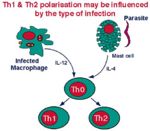Adaptive Immune System - Overview
Introduction
Adaptive immunity is a defence system built on specific cellular targeting. It takes time for the immune system to develop its weaponry (up to 96 hours after infection), but ultimately the adaptive response is far more effective because of its precision.
Once infection is identified, antigen is transported to lymphoid organs where it is recognised by naive B and T cells. Clonal expansion and differentiation of these cells occurs, and then the battle begins. The immune system can take several tacks, depending on the type of infection encountered. Ultimately, the goals of the adaptive response are two-fold: to produce neutralising antibody, and to flag up infected cells for destruction. This annihilation can be carried out by the cells of both innate and adaptive immunity.
Actions of the Adaptive Immune System
Adaptive immunity is stimulated by the generic actions of innate immunity. Once a foreign organism is identified by the innate immune system, circulating T-cells begin interacting with foreign antigen. Based on their encounter, they can do one of three things: they can kill infected cells directly, they can boost the actions of macrophages to kill infected cells, or they can return to lymph tissue to incite a B cell response. Stimulated B cells will proceed to produce antibody, which can then circulate to fight the infection.
Antigen Recognition
"Antigen" refers to the parts of a foreign organism recognisable by the adaptive immune system. Typically, these are structural proteins, such as the spike proteins of viruses. Antigens can be huge, and are more often identified by epitopes, or smaller fragments of the folded proteins. As such, a single antigen can be recognised by multiple antigen receptors. Antibody has evolved to recognise a dizzying array of antigen epitopes. Antigen can be picked up by lymphocytes in the lymph tissues (T cells and B cells) or the blood stream (T cells only).
T cell receptors (TCR) recognise antigen fragments (that is digestion products) on the surface of cells, whereas B cell receptors (BCR) bind whole antigen in the extracellular fluid. T cells only "see" antigen when it is presented by MHC (Major Histocompatibility Complex) on the cell surface. Antigen digestion and presentation is one of the major functions of the dendritic cells (circulating monocytes) and macrophages. These are referred to as Antigen-Presenting Cells (APCs).
Naive B-cells express IgD and IgM on their cell surfaces, which bind antigen as it is washed into lymph tissue with the afferent lymph fluid. Antigen is presented to B cells by follicular dendritic cells (FDCs), which are also classed as APCs. FDCs can endocytose antigen directly from the afferent lymph or receive them from CD4+ T-cells.
Cellular response: Proliferation and Differentiation
- T cell response
Once T cells recognise antigen presence in the tissues, they go into action. Their first response is always to recruit help, which is accomplished by returning to the nearest lymph node to carry out clonal expansion. Daughter T cells are created with identical TCRs in order to recognise the identified antigen. These daughter cells are then returned to the circulation via the efferent lymph.
T cells can differentiate three different ways, based on their Cluster of Differentiation (CD) number. All T cells are CD3+, and naive circulating T cells will differentiate upon interaction with antigen to become either CD8+ (cytotoxic) or CD4+ (helper) T cells. CD4+ T-cells will initially become CD4+-TH0 cells, and must differentiate to TH1, TH2 or TH17 cells depending on the whim of the adaptive response (TH17cells are a recent addition to this model, with research still being conducted into function). TH1, TH2 and TH17 cells carry out different types of responses: TH1 is responsible for enhancing the macrophage response, whereas TH2 cells enhance the B cell antibody production, and TH17 cells enhance the innate immune response through increased granulocyte trafficking. Typically, animals produce a balanced response of TH cells, though this can lead to pathology, as can a skewed response, depending on the nature of the foreign organism. For more on T cell differentiation, see here.
- B cell response
Naive B cells recognise antigen in the lymph tissue when it is presented to them by Follicular Dendritic Cells (FDCs). They also undergo clonal expansion, creating a germinal center in the follicle as they develop and mature into plasma cells. Once mature, plasma cells in the lymph node migrate to the medullary cords and begin secreting antibody into the efferent lymph. Antibody eventually reaches the circulation in order to wage war on the intruder. For more on B cell differentiation, see here.
Tools of the Adaptive Immune System
Antigen Presenting Cells
To B-cells:
To T-cells, via MHC presentation on:
- Macrophages
- Interdigitating Dendritic Cells
- Only IDCs can incite a primary response in naive T-cells
- CD4+ Tcells
- B-cells
Antigen Binding Molecules
Links
Wikivet
Websites
Lectures
- Prof Dirk Werling DrMedVet PhD MRCVS
| Originally funded by the RVC Jim Bee Award 2007 |
Error in widget FBRecommend: unable to write file /var/www/wikivet.net/extensions/Widgets/compiled_templates/wrt6621fcdb36de36_27538292 Error in widget google+: unable to write file /var/www/wikivet.net/extensions/Widgets/compiled_templates/wrt6621fcdb41a7f1_81960767 Error in widget TwitterTweet: unable to write file /var/www/wikivet.net/extensions/Widgets/compiled_templates/wrt6621fcdb4e3564_95825384
|
| WikiVet® Introduction - Help WikiVet - Report a Problem |



